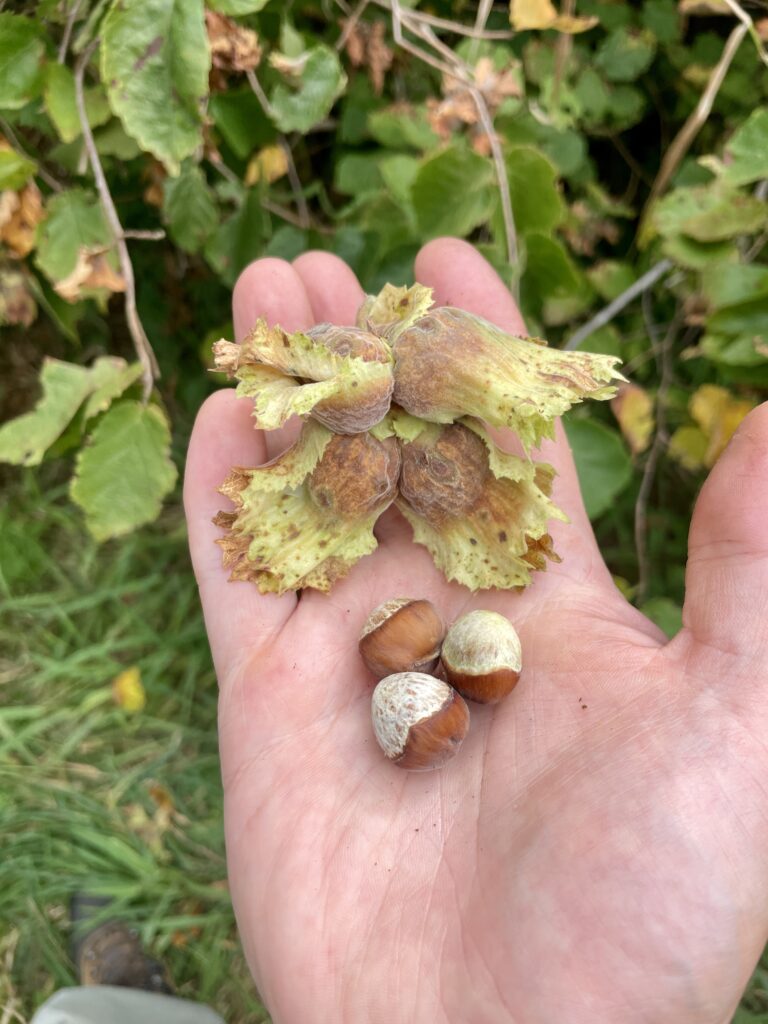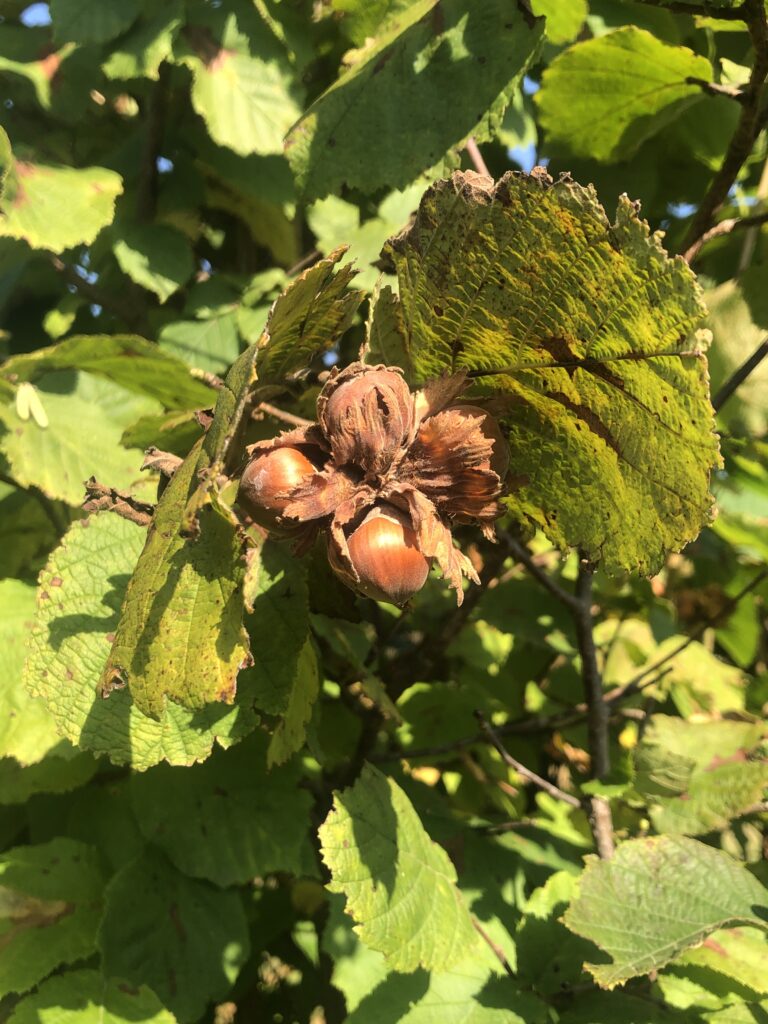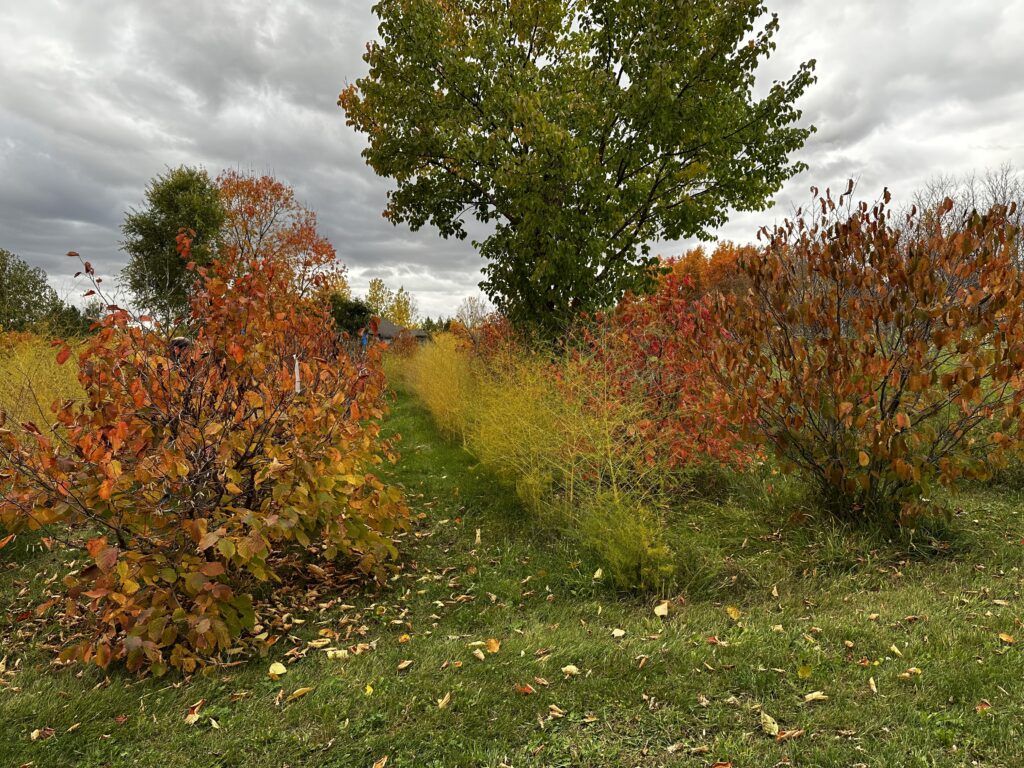A Culinary and Ecological Movement
By Stacy Carlson

Walking among twenty-year-old hazel shrubs laden with nuts, I’m surrounded by evidence of a thriving ecosystem: Boisterous trills and buzzing fill the air as tree frogs, birds, dragonflies and bees go about their late-summer business, making the most of the shady cover and blooming goldenrod among the rows.
I am visiting Nine Hazels Farm in Lake City, and the longer I spend with the shrubby bushes in this food forest, the more enchanted I feel. The grove harbors nests, burrows and grassy indentations where deer have slept. This, combined with the abundance of ripe nuts in their dumpling-like husks, sparks a welcome optimism.
Nine Hazels is part of a movement of growers, research initiatives and companies collaborating to make hazelnuts a successful commercial crop in the Upper Midwest. While the focus and goals of these organizations may differ slightly, a constant at the heart of the local hazelnut movement is regenerative thinking – a shared vision to leave the land healthier than before and to support biodiversity while producing nuts and other goods for human consumption.
In the Upper Midwest, the American hazel, Corylus americana, and beaked hazel, Corylus cornuta, are native to our oak savanna ecosystem and have been part of Indigenous foodways for millennia. Hazel’s appeal spans continents and centuries, from ancient China to Celtic lore, and today more people are growing, buying and enjoying its versatile and delicious fruit – the hazelnut – right here at home. Because our two native hazel species bear thick-shelled, tiny nuts, they aren’t a good fit for large-scale cultivation. The hazels grown by Nine Hazels and approximately 150 other small farms across the Upper Midwest today are the product of crossing the native nuts with Corylus avellana, the European hazel that has historically produced the world’s hazelnuts.



The hybrid hazels deliver winter hardiness, disease- and drought-resistance and easily shelled nuts that pack an unbeatable flavor. The hard work of many has created a gourmet product. Plus growing hazels offers a suite of impressive environmental benefits.
“On the farm you can really see what twenty years of perennials does to the land,” says Paul Mairet, who operates Nine Hazels Farm with his wife, Sanna. “We’re on a floodplain, so these hazels were planted in sand. Over the years, they’ve built the soil in an amazing way. Their root structure provides aeration, and holds soil and water in place, which in turn prevents erosion and reduces flooding. The fallen leaves build an organic layer, which serves as a sponge for nutrients and water.”
Paul explains that after the first year of growth, their hazels don’t require irrigation, and they’re tolerant of extra-wet weather too. Given that over the past decade Minnesota has seen both the wettest year on record (2016) and severe drought (2021), this hardiness is exceptionally significant. As a climate-resilient cherry on top, one acre of mature hazels can sequester up to 18 tons of carbon over the lifetime of the shrubs, reducing the greenhouse gasses in the atmosphere that contribute to global warming.
The Mairets purchased their 30-acre farm and its 4,000 hazels in 2019 from Norm and Mary Erickson, who planted the bushes in 2004 and were lively advocates for the crop. In 2010, the Ericksons even got Lake City named the ‘Hazelnut Capitol of Minnesota’. “We came to this farm from a gardening and nature-loving background, with no previous farm-scale experience,” Paul says. “It was great to work together with the Ericksons starting out, and what we’ve seen is that the hazel hedgerows are home to a great number of different plants and animals. For us, the health of the ecosystem is paramount.”
In their grove, the Mairets practice coppicing, an ancient method of cutting woody perennials to the ground and allowing them to regrow. This rejuvenates the bushes, allowing older hazels to return to peak nut production over a period of about three to five years. Paul uses coppiced wood to create crafts including wreaths, trays and fence panels. He leaves the unusable deadwood stacked in the grove to provide wildlife habitat.
“A family of bobwhite quail spent last summer on the farm,” Paul and Sanna share. “It was the first time we’d seen this near-threatened bird. Quail like mixed tall and short grasses and enclosed, branchy areas to hide. We were delighted they found the hazels and deadwood. Small farms used to leave wild edges around their fields and practice selective mowing. Today’s monocrops don’t provide the bobwhites what they need, so their numbers dwindled. We see the fact that the bobwhites made a home here as a big success.”
In addition to hazelnuts and coppice crafts, Nine Hazels sells seed nuts and bare-root seedlings for those who’d like to grow hazels themselves. Paul and Sanna also produce small-batch, pure hazelnut oil as a sustainable skincare product.
A few weeks after my farm visit, I’m walking among hazels again. It’s autumn and I’m surrounded by a different type of boisterous community: Instead of birdsong, conversation and laughter fill the air as people with canvas harvest bags pick nuts in groups of two or three.
I’m participating in a volunteer event in Farmington where hazels grow as part of the breeding program started more than twenty years ago. This event is an example of the collaboration among different groups to develop and market hazelnuts. I’m greeted by Andrew from UMN’s Forever Green Initiative, which develops a suite of winter-hardy crops that protect soil and water across the state, including hazels. He directs me to the gathering’s de-facto host, Lois Braun, longtime hazelnut researcher at UMN and member of the Upper Midwest Hazelnut Development Initiative (UMHDI) – a research and development group that has been a driving force behind the movement.

“I started as a graduate student in 2002, with the assignment to figure out fertilization rates for hybrid hazelnuts,” Lois says as she plucks hazelnuts with lightning speed. She explains that hybrid hazels have been bred informally on a very small scale for 100 years in our region, but not using scientific methods. Her team wasn’t starting from scratch, but because hazels have so much genetic variability and take up to three years after planting to produce nuts, the journey to develop consistent, commercially viable cultivars has been a decades-long process that is still ongoing.
“It’s usually a seventeen-year cycle to get new cultivars into the market,” Lois shares. “Breeders make controlled crosses in spring, harvest in fall, plant seeds the following spring and transplant in fall. That’s year one. Then the seedlings grow for two to three years. In years three, four and five they’re starting to produce nuts. Then we evaluate the nuts for three-plus years. Only then do we choose the best nuts and propagate them. So, every individual plant that comes out of the process is like a reshuffled deck of cards with endless genetic combinations.”
The Farmington field, with 4,000 genetically unique hazel bushes, is a crucial part of the long-term plan to get hazel cultivars into the market. Weeks before the volunteer event, Lois and her team harvested nuts from the best-performing bushes, and she’s working on propagation for the next round. The breeding program hopes to offer cultivars to the public through retail nurseries in the next year or two.
Soon Lois is off to another row of hazels, and I continue meeting fascinating people gathered for the harvest. There’s a trained tree care volunteer and pollinator ambassador; the founder of a granola company who declares hazelnuts to be her favorite nut of all; a local author who picked wild hazelnuts as a child; and a master gardener who extols the nut’s unique sweetness and smooth texture. Finally, I encounter Rebecca Flood, a former Minnesota Pollution Control Agency assistant commissioner who spent her career working to improve the state’s water resources. She is quick to put in a good word. “Perennial crops like hazels that provide continuous ground cover do so much to restore Minnesota’s polluted waterways, by taking in nitrogen from agricultural fertilizers so it doesn’t end up in creeks and rivers.”
Like the thriving ecosystem at Nine Hazels Farm, this enthusiastic community brings a welcome optimism in a time of increasing climate-related challenges, reminding me that moving toward a healthier future, including local, environmentally beneficial food crops, can be a joyful experience.
Even after Lois’ harvest for genetic research, thousands of hazelnuts remain on the Farmington bushes, and everything we’re harvesting will go to the American Hazelnut Company (AHC), another integral piece of the hazelnut market development puzzle. Born a decade ago out of UMHDI and other collaborations, and working across four Midwestern states, AHC serves several important purposes as the hazelnut movement expands.
The grower-owned company buys hazelnuts from small farmers and cleans, shells and sorts them at its processing plant in Ashland, Wisconsin. It then turns the nuts into delicious products, markets them, and sells directly to consumers. Emma Dempsey is AHC’s sales and marketing manager and has brought many friends and colleagues to the harvesting event.
“Right now in the Upper Midwest there are only about 150 acres of mature hazels in cultivation,” Emma explains. “We provide a shared facility so that small farmers don’t have to process the nuts themselves. New farmers aren’t going to grow hazelnuts on a larger scale without a market, so we’re developing a brand, products, and finding the customers.”
Those products include roasted and seasoned hazelnuts, culinary hazelnut oil, hazelnut flour, and a new line of trail mix in development. Emma tells me that right now, customer demand comes very close to exceeding supply, which is exactly what the emerging hazelnut market needs.
“I don’t think people are used to eating fresh nuts,” Emma says. “Once they do, it’s hard to go back. Our hazelnuts are roasted right before the orders come in. They’re not years old, which unfortunately can be the case with other nuts. Local hazelnuts taste rich and decadent; the taste is buttery almost like a macadamia, but with more flavor.”
From biscotti and berry tart crust to hazelnut oil vinaigrette and everyday snacking, this versatile local delicacy packs a toasty flavor to both sweet and savory dishes and desserts.
“Once folks discover how great hazelnuts are, they become part of a new category for local food: sustainably grown nuts,” Emma continues. “It’s the same logic as why you buy local tomatoes: the product is fresher and you’re supporting local farmers. If you were to picture in your mind an ideal sustainable crop in the Midwest, it would be a perennial with low water usage that is resistant to pests, disease, drought and flood, and that sequesters carbon and creates habitat. That describes hazels. The environmental benefits are amazing.”
According to UMHDI, the 150 acres currently in production in the Upper Midwest results in an estimated 40,000 pounds of nuts annually. With a goal to get 20,000 acres into production by 2030, the initiative’s well-coordinated breeding, growing, distribution and market development plans could result in about 2.6 million pounds of local hazelnuts produced annually.
As if that weren’t enough, Emma describes the way many of AHC’s grower-owners interplant different annual and perennial crops among their hazels, like asparagus and raspberries. Tree-Range Farms in Northfield takes intercropping to the next level with their truly free-range chickens raised among hazels, foraging for insects and nuts in a jungle-like habitat similar to the places where chickens evolved. The potential for second income streams for growers that complement hazel production is wide open.
By the end of the harvest event, with visions of hazelnuts dancing in my head, I am excited by the potential of hazels to help build a regenerative future in which our farming practices and foodways leave the land better than we found it, generation after generation. That ancient hazel magic is alive and well in the Upper Midwest – but since nothing changes with the simple wave of a magic wand, it will be the support of consumers that will help make sure this perennial food forest continues to grow.
Stacy Carlson is a novelist, naturalist, and home herbalist based in Minneapolis. She serves as education program manager for Women’s Environmental Institute, a grassroots nonprofit dedicated to organic farming and food justice. Her background also includes work as a historical ecologist, hot springs caretaker, biological field crew on a bird refuge in SE Alaska, and hiking guide in Big Sur.
Where to find Minnesota Hazelnut Products
Nine Hazels Farm
Online at ninehazelsfarm.com

